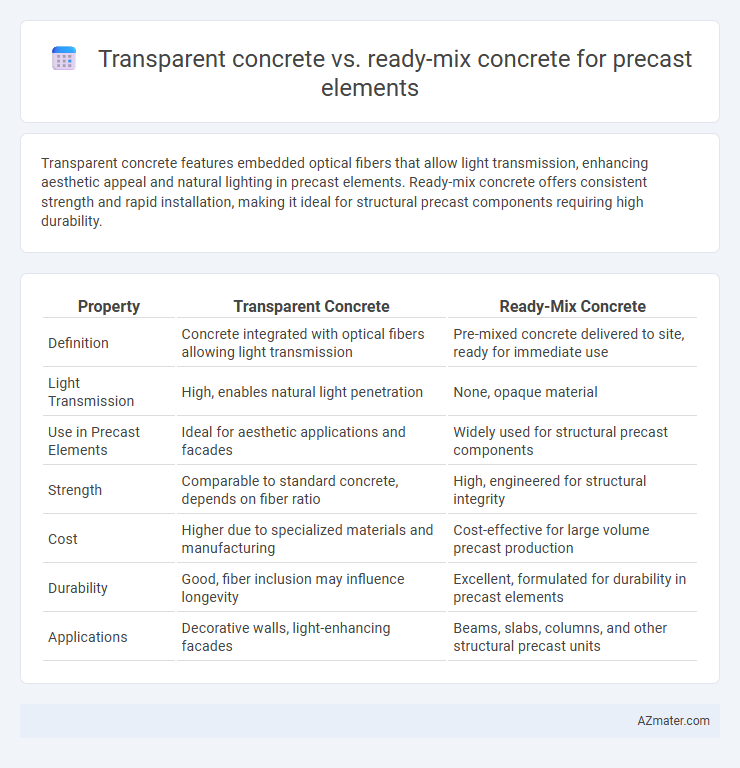Transparent concrete features embedded optical fibers that allow light transmission, enhancing aesthetic appeal and natural lighting in precast elements. Ready-mix concrete offers consistent strength and rapid installation, making it ideal for structural precast components requiring high durability.
Table of Comparison
| Property | Transparent Concrete | Ready-Mix Concrete |
|---|---|---|
| Definition | Concrete integrated with optical fibers allowing light transmission | Pre-mixed concrete delivered to site, ready for immediate use |
| Light Transmission | High, enables natural light penetration | None, opaque material |
| Use in Precast Elements | Ideal for aesthetic applications and facades | Widely used for structural precast components |
| Strength | Comparable to standard concrete, depends on fiber ratio | High, engineered for structural integrity |
| Cost | Higher due to specialized materials and manufacturing | Cost-effective for large volume precast production |
| Durability | Good, fiber inclusion may influence longevity | Excellent, formulated for durability in precast elements |
| Applications | Decorative walls, light-enhancing facades | Beams, slabs, columns, and other structural precast units |
Introduction to Precast Concrete Elements
Precast concrete elements are factory-produced components used in construction for faster assembly and consistent quality. Transparent concrete incorporates optical fibers or resin to allow light transmission, enhancing aesthetic appeal and natural illumination in architectural applications. Ready-mix concrete offers uniform strength and durability but lacks the light-transmitting properties essential for design innovation in precast translucent elements.
What is Transparent Concrete?
Transparent concrete is an innovative building material that incorporates optical fibers or resin-based elements to allow light transmission while maintaining structural strength, making it ideal for architectural precast applications requiring natural lighting and aesthetic appeal. Unlike traditional ready-mix concrete, which is opaque and primarily focused on compressive strength and workability, transparent concrete offers unique translucency properties without compromising durability. This material enables designers to create precast elements with both functional load-bearing capacity and enhanced light diffusion, setting it apart in modern construction projects.
What is Ready-Mix Concrete?
Ready-mix concrete is a highly controlled concrete production process delivered to construction sites in a plastic, unhardened state through specialized transit mixers, ensuring uniform quality and consistency for precast elements. It consists of cement, water, aggregates, and admixtures mixed at a batching plant under strict quality control standards, optimizing strength, durability, and workability. Compared to transparent concrete, ready-mix concrete offers versatility and cost-effectiveness for large-scale precast applications but lacks the light-transmitting properties required for architectural aesthetics.
Material Composition and Properties
Transparent concrete incorporates optical fibers embedded within a fine concrete matrix, enabling light transmission while maintaining structural integrity, making it suitable for aesthetic precast elements requiring translucency. Ready-mix concrete for precast typically consists of cement, aggregates, water, and admixtures tailored for strength, durability, and workability but lacks translucency and light-transmitting properties. The inclusion of optical fibers in transparent concrete results in lower compressive strength compared to conventional ready-mix concrete but offers unique properties like light diffusion and visual appeal for architectural precast applications.
Manufacturing Process Differences
Transparent concrete incorporates optical fibers or light-transmitting elements embedded within a cementitious matrix, requiring precise alignment and careful handling during the mixing and casting stages to preserve transparency properties. Ready-mix concrete for precast elements is produced by batching ingredients at a central plant, emphasizing uniform consistency and strength, followed by transportation to the precasting site for molding and curing. The manufacturing of transparent concrete involves additional complexity due to the integration of light-transmitting components, contrasting with the standardized, streamlined production process of ready-mix concrete.
Structural Performance Comparison
Transparent concrete offers innovative structural performance with embedded optical fibers that enhance light transmission without significantly compromising load-bearing capacity, making it suitable for architectural precast elements requiring natural illumination. Ready-mix concrete provides consistent compressive strength and durability, widely favored for standard precast structural components due to its proven performance under various loading conditions. Comparison reveals that while ready-mix concrete excels in strength and cost-efficiency, transparent concrete balances aesthetics with adequate structural integrity, requiring careful design consideration to meet specific load requirements in precast applications.
Light Transmission and Aesthetic Benefits
Transparent concrete, embedded with optical fibers, offers superior light transmission compared to ready-mix concrete, enabling natural daylight to pass through precast elements and creating visually striking effects. Ready-mix concrete provides uniformity and strength but lacks translucency, limiting aesthetic versatility in architectural applications. The integration of transparent concrete in precast elements enhances building design by merging structural integrity with innovative light diffusion and dynamic visual appeal.
Cost Analysis: Transparent vs Ready-Mix Concrete
Transparent concrete, incorporating optical fibers or light-transmitting elements, significantly increases material costs compared to traditional ready-mix concrete due to specialized manufacturing and raw materials. Ready-mix concrete benefits from streamlined production and bulk sourcing, resulting in lower per cubic meter expenses and faster procurement for precast elements. The higher initial investment in transparent concrete can be offset in architectural applications by enhanced aesthetics and light transmission, but budget constraints often favor ready-mix concrete for standard precast construction projects.
Sustainability and Environmental Impact
Transparent concrete incorporates optical fibers or recycled glass, enabling natural light transmission and reducing energy consumption for lighting in buildings, which significantly enhances sustainability. Ready-mix concrete, widely used in precast elements, relies heavily on Portland cement production, a major source of CO2 emissions, but advancements in supplementary cementitious materials improve its environmental footprint. Transparent concrete's innovative design not only lowers operational energy costs but also supports circular economy principles through material reuse, making it a greener alternative in sustainable precast construction.
Best Applications for Precast Elements
Transparent concrete provides unique aesthetic appeal and light-transmitting properties, making it ideal for architectural precast elements like facade panels and decorative walls. Ready-mix concrete offers superior strength, uniformity, and cost-efficiency, making it suitable for structural precast components such as beams, columns, and slabs. The best applications balance visual design with structural demands, where transparent concrete enhances appearance and ready-mix concrete ensures durability and load-bearing capacity.

Infographic: Transparent concrete vs Ready-mix concrete for Precast element
 azmater.com
azmater.com